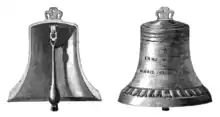List of heaviest bells
Following is a list of the heaviest bells known to have been cast, and the period of time during which they held that title.
Heaviest functioning bell in the world
The title of heaviest functioning bell in the world has been held chronologically by:
| Year | lb | short tons | kg | Bell | Fate |
|---|---|---|---|---|---|
| 732 | 96,000 | 48 | 43,545 | Tōdai-ji | Surpassed |
| 1484 | 655,000 | 327.5 | 297,103 | Great Bell of Dhammazedi | Sank during transport |
| 1602 | 96,000 | 48 | 43,545 | Tōdai-ji | Surpassed |
| 1633 | 148,000 | 74 | 67,132 | Chion-in Temple | Surpassed |
| 1810 | 195,000 | 97.5 | 88,451 | Mingun Bell | Fell during earthquake (raised again in 1896) |
| 1839 | 148,000 | 74 | 67,132 | Chion-in Temple | Surpassed |
| 1896 | 195,000 | 97.5 | 88,451 | Mingun Bell | Surpassed |
| 1902 | 251,000 | 125.5 | 113,852 | Shitennō-ji Temple Bell | Recycled for war |
| 1942 | 195,000 | 97.5 | 88,451 | Mingun Bell | Surpassed |
| 2000 | 255,736 | 127.6 | 116,000 | Bell of Good Luck | Incumbent |
The Great Bell of Dhammazedi
At approximately 300 tons, the Great Bell of Dhammazedi is the largest bell to have existed in recorded history.[1] Cast in 1484 by King Dhammazedi of Mon, this bell was located at the Shwedagon Pagoda in Rangoon, Burma (now Yangon, Myanmar). The bell was said to be twelve cubits (6.276 m) high and eight cubits (4.184 m) wide. Click here to see a drawing of the bell as it appeared while still at the Shwedagon Pagoda.
The Great Bell of Dhammazedi remained at the Shwedagon Pagoda as the heaviest functioning bell in the world until 1602. That year, Portuguese warlord and mercenary Philip de Brito removed it and attempted to carry it by a specially constructed raft down the Yangon River to his stronghold of Thanlyin (later known as Syriam). However, the ship carrying the bell sank at the confluence of the Yangon and Bago rivers. The Dhammazedi Bell remains buried to this day at that location, possibly well-preserved, beneath some 25 feet (7.6 m) of sediment. Numerous attempts have been made to locate and recover the bell, thus far without success.[2][3]
So while the Great Bell of Dhammazedi might indeed be the heaviest bell in the world, it must be disqualified from consideration as such, until it has been recovered and restored to a functional status.
The Chion-in Temple Bell
Cast in 1633, the 74-ton Chion-in Temple Bell, located in Kyoto, Japan, held the title of heaviest functioning bell in the world until 1810.[4]
From March 1839 until March 1896, the Mingun Bell was not functional due to the fact that it was not hanging freely from its shackles. During this period, the Chion-in Temple Bell regained its former title.[4]
The Mingun Bell
Cast in 1808, the 90-ton Mingun Bell in Mingun, Sagaing Division, Burma became the heaviest functioning bell in the world from its suspension in 1810 until 23 March 1839. On that date, it was knocked off its supports by a large earthquake. Click here to see a photograph of the Mingun Bell as it appeared in the late 1800s.
The Mingun Bell was resuspended in March 1896 by a team of men from the Irrawaddy Flotilla Company.[5] The Mingun Bell was again the world's heaviest functioning bell from its resuspension in 1896 until 1902.
The Mingun Bell regained its status as the heaviest functioning bell in the world in 1942.
The Shitennō-ji Temple Bell
In 1902, the newly-cast 114-ton Shitennō-ji Temple Bell was hung in Osaka, Japan.[6] The Shitennō-ji Temple Bell reigned as the heaviest functioning bell in the world from that year until 1942, when it was melted down for its metal to assist with the then-ongoing World War II effort.[6]
The Bell of Good Luck
Cast on New Year's Eve 2000, the Bell of Good Luck is located in the Foquan Temple in Pingdingshan, Henan, China.[7][8] The bell weighs 116 metric tons and it is 810.8 cm (318 in) in height and 511.8 cm (201 in) in diameter.[7][8] The Bell of Good Luck has therefore claimed the title of heaviest functioning bell in the world since its construction in 2000, up to the present date.
The Tsar Bell
The 216-ton Russian Tsar Bell (also known as the Tsar Kolokol III) on display on the grounds of the Moscow Kremlin is the heaviest bell known to exist in the world today.[9] However, a very large piece broke off from the Tsar Bell during a fire which engulfed the tower the bell was intended to be hung in, so this irreparably damaged bell has never been suspended or rung. The Tsar Bell cannot be considered as the heaviest functioning bell in the world due to its inability to serve as a percussion instrument. Rather, it may be considered to be the largest bell, or at least the largest bell-shaped sculpture in the world.
Existing bells
Bells weighing 50000 lbs (25 tons) or more:
| Name of bell (or edifice containing bell) | Location | Weight (lbs) | Year cast | Manufacturer or foundry | Notes |
|---|---|---|---|---|---|
| Tsar Bell | Moscow Kremlin, Moscow, Russia | 445,166 pounds (201,924 kg) | 1735 | Ivan Feodorovich Motorin | broken[10] |
| Bell of Good Luck | Foquan Temple, Fodushan Scenic Area, Pingdingshan, Henan, China | 255,200 pounds (115,800 kg) | 2000 | Tianrui Group | currently the heaviest functioning bell in the world[7][8][11] |
| Mingun Bell | Mingun, Myanmar | 195,000 pounds (88,000 kg) | 1808 | unknown | [11] |
| Tsarsky Kolokol | Trinity Lavra of St. Sergius, Sergiyev Posad, Moscow Oblast, Russia | 158,400 pounds (71,800 kg) | 2004 | Zavod imeni Likhacheva, Moscow, Russia | [10] |
| Chion-in Temple Bell | Kyoto, Japan | 148,000 pounds (67,000 kg) | 1633 | unknown | [4] |
| Great Uspensky Bell (also known as Great Assumption Bell) | Moscow Kremlin, Moscow, Russia | 144,452 pounds (65,522 kg) | 1817 | Yakov Zavyalov and Rusinov | [10] |
| Tōdai-ji Temple Bell | Nara, Japan | 96,000 pounds (44,000 kg) | 732 | unknown | [11] |
| Yongle Bell | Da Zhong Si (Great Bell Temple), Beijing, China | 93,000 pounds (42,000 kg) | ca. 1420 | unknown | [11] |
| Name unknown | Moscow, Russia | 88,000 pounds (40,000 kg) | 1600 | Andrey Chokhov | [10] |
| Tharrawaddy Min Bell | Shwedagon Pagoda, Yangon, Myanmar | 84,000 pounds (38,000 kg) | 1842 | Maha Sithu and Maha Min Kyaw Thinkhaya[12] | [11] |
| Gotenba Bell | Toki no Sumika Park, Gotemba, Shizuoka, Japan | 79,750 pounds (36,170 kg) | 2006 | Royal Eijsbouts bell foundry | [11][13] |
| Đại hồng chung | Bai Dinh Pagoda, Gia Vien, Ninh Binh, Vietnam | 79,336 pounds (35,986 kg) | 2007 | Nguyễn Văn Sở, Huế, Vietnam | [14] |
| Blagovestnik (also known as Firstborn) | Trinity Lavra of St. Sergius, Sergiyev Posad, Moscow Oblast, Russia | 78,250 pounds (35,490 kg) | 2002 | Zavod imeni Likhacheva, Moscow, Russia | [10] |
| Savvino-Storozhevsky Monastery | Zvenigorod, Moscow Oblast, Russia | 77,000 pounds (35,000 kg) | 2003 | Vera LLC, Shilova, Voronezh, Russia | [10][15] |
| Yuriev Monastery | Veliky Novgorod, Novgorod Oblast, Russia | 75,837 pounds (34,399 kg) | unknown | [10] | |
| World Peace Bell | Newport, Kentucky, U.S. | 73,381 pounds (33,285 kg) | 1998 | Fonderie Paccard | [16] |
| Kazansky Monastery | Tambov, Tambov Oblast, Russia | 72,226 pounds (32,761 kg) | unknown | [10] | |
| Kirillo-Belozersky Monastery | Kirillov and Belozersk, Vologda Oblast, Russia | 72,226 pounds (32,761 kg) | unknown | [10] | |
| Saint Isaac's Cathedral | Saint Petersburg, Russia | 67,191 pounds (30,477 kg) | mid-19th century | unknown | [10] |
| Torzhestvennyj Bell | Cathedral of Christ the Saviour, Moscow, Russia | 59,749 pounds (27,102 kg) | 1878 | unknown | [10] |
| Evangelist (bell) | Trinity Lavra of St. Sergius, Sergiyev Posad, Moscow Oblast, Russia | 59,400 pounds (26,900 kg) | 2002 | Zavod imeni Likhacheva, Moscow, Russia | [10] |
| Saint Sophia Cathedral | Veliky Novgorod, Novgorod Oblast, Russia | 58,286 pounds (26,438 kg) | 1659 | unknown | [10] |
| St. Petersglocke | Cologne Cathedral, Cologne, Germany | 52,800 pounds (23,900 kg) | 1923 | Heinrich Ulrich | The heaviest bell in the world which hangs on a straight bar, and the largest bell to be rung by swinging.[17] |
| Sysoi | Assumption Cathedral in Rostov, Rostov-Velikij, Yaroslavl Oblast, Russia | 52,000 pounds (24,000 kg) | 1689 | Flor Terentyev | [10][18] |
| Singu Min Bell | Shwedagon Pagoda, Yangon, Myanmar | 50,600 pounds (23,000 kg) | 1779 | unknown | [11][19] |
Destroyed or lost bells
Bells weighing 50000 lbs (25 tons) or more, no longer in existence (lost or destroyed):
| Name of bell (or edifice containing bell) | Location | Weight (lbs) | Year cast | Manufacturer or foundry | Notes |
|---|---|---|---|---|---|
| Great Bell of Dhammazedi | Shwedagon Pagoda, Yangon, Myanmar | 655,000 pounds (297,000 kg) | 1484 | unknown | submerged in the Bago River in 1608; may be recoverable[11] |
| Shitennō-ji Temple Bell | Osaka, Japan | 251,000 pounds (114,000 kg) | 1902 | unknown | destroyed 1942[11] |
| Tsarsky Kolokol Bell (aka ‘’Trotzkoi Bell’’) | Trinity Lavra of St. Sergius, Sergiyev Posad, Moscow Oblast, Russia | 144,452 pounds (65,522 kg) | 1748 | unknown | destroyed 1930[10] |
| Savvino-Storozhevsky Monastery | Zvenigorod, Moscow Oblast, Russia | 76,767 pounds (34,821 kg) | 1667 | unknown | destroyed 1941[10] |
| Godunov Bell (also known as Old Assumption Bell, or Resurrection Bell) | Trinity Lavra of St. Sergius, Sergiyev Posad, Moscow Oblast, Russia | 66,809 pounds (30,304 kg) | ca. 1600 | Andrey Chokhov | destroyed 1701[10] |
| Kaiserglocke | Cologne Cathedral, Cologne, Germany | 61,160 pounds (27,740 kg) | 1874 | Andreas Hamm | destroyed 1918[17] |
Gallery
 Tsar Bell (Moscow, Russia)
Tsar Bell (Moscow, Russia) Mingun Bell (Mingun, Myanmar)
Mingun Bell (Mingun, Myanmar) Bell Tower, Trinity Lavra of St. Sergius (Moscow, Russia)
Bell Tower, Trinity Lavra of St. Sergius (Moscow, Russia) Chion-in Temple Bell (Kyoto, Japan)
Chion-in Temple Bell (Kyoto, Japan) Ivan the Great Bell Tower and Assumption Belfry (Moscow, Russia)
Ivan the Great Bell Tower and Assumption Belfry (Moscow, Russia) Tōdai-ji Temple Bell (Nara, Japan)
Tōdai-ji Temple Bell (Nara, Japan) Yongle Bell (Beijing, China)
Yongle Bell (Beijing, China) Tharrawaddy Min Bell (Yangon, Myanmar)
Tharrawaddy Min Bell (Yangon, Myanmar) Shitennō-ji Temple Bell (Osaka, Japan)
Shitennō-ji Temple Bell (Osaka, Japan) World Peace Bell (Newport, Kentucky, USA)
World Peace Bell (Newport, Kentucky, USA) St. Petersglocke (Cologne, Germany)
St. Petersglocke (Cologne, Germany) Maha Ganda Bell (Yangon, Myanmar)
Maha Ganda Bell (Yangon, Myanmar)
See also
References
- World's Three Biggest Bells
- Largest Bell under water Archived 2012-09-13 at Archive.today
- Mike Hatcher
- Chion-in Temple, Kyoto
- Bird, George W (1897). Wanderings in Burma, pages 318–319. London: Simpkin, Marshall, Hamilton, Kent & Co., Ltd.
- Price, Percival (1983), Bells and Man, Oxford: Oxford University Press, pp. 264–273 (App. A: An historical survey of bells around the world)
- "Fodushan Scenic Area:The Bell of Good Luck". Archived from the original on 2018-09-30. Retrieved 2010-01-01.
- The Bell of Good Luck: the largest working bell in the world
- Slobodskoy, Archpriest Seraphim (1996), "Bells and Russian Orthodox Peals", The Law of God, Jordanville, N.Y.: Holy Trinity Monastery, p. 624, ISBN 0-88465-044-8
- Great Bells of Russia
- Great Oriental Bells of Asia and the Pacific Rim
- Maung Maung Tin (1905). Konbaung Set Yazawin. 3 (2004, 4th ed.). p. 32.
- Royal Eijsbouts Bell Foundry:Gotenba Bell
- http://vnexpress.net/gl/xa-hoi/2010/02/3ba19017/
- 'Most sonorous' bell of all Russia is recast (35 tons)
- Paccard Bell Foundry
- Great bells of Europe by weight
- Photographs of Sysoi
- Click here to see a photograph of the Maha Ganda Bell as it appeared, circa 1897.
External links
- Blagovest Russian Church Bells:A Select List of Russian Bells Weighing 36,100 Pounds or More
- Guild of Carillonneurs in North America
- Russian Orthodox leader blesses new church bells at holy site
